The AMD Radeon R9 290 Review
by Ryan Smith on November 5, 2013 12:01 AM EST- Posted in
- GPUs
- AMD
- Radeon
- Hawaii
- Radeon 200
Overclocking
Finally, let’s spend a bit of time looking at the overclocking prospects for the 290. Without any voltage adjustment capabilities and with AMD binning chips for clockspeeds and power consumption we’re not necessarily expecting a lot of headroom here, but none the less it’s worth checking out to see how much more we can squeeze out of the card.
Even though we’re officially limited to AMD’s Overdrive utility for the moment for overclocking, Overdrive offers a wide enough range of values that we shouldn’t have any problem maxing out the card. In fact we’ll be limited by the card first.
| Radeon R9 290 Overclocking | |||
| Reference Radeon R9 290 | |||
| Shipping Core Clock | 662MHz | ||
| Shipping Boost Clock | 947MHz | ||
| Shipping Memory Clock | 5GHz | ||
| Shipping Boost Voltage | ~1.18v | ||
| Overclock Core Clock | 790MHz | ||
| Overclock Boost Clock | 1075MHz | ||
| Overclock Memory Clock | 5.6GHz | ||
| Overclock Max Boost Voltage | ~1.18v | ||
Despite the lack of voltage control, when it comes to overclocking the 290 we were able to achieve solid overclocks on both the GPU and the memory. On a boost clock basis we were able to push the 290 from 947MHz to 1075MHz, an increase of 128MHz (14%). Meanwhile we were able to push the memory from 5GHz to 5.6GHz before artifacting set in, representing a 600MHz (12%) memory overclock. Being able to increase both clockspeeds to such a similar degree means that no matter what the video bottleneck is – be it GPU or memory – we should see some kind of performance increase out of overclocking.
On a side note, for overclocking the 290 we stuck with moderate increases to both the maximum fan speed and the PowerTune limit. In the case of the former we used a 65% maximum fan speed (which actually proved to be more than what’s necessary), while for the latter we went with a 20% increase in the PowerTune limit, as at this point in time we don’t have a good idea for what the safe power limits are for the reference 290/290X board. Though in either case only FurMark could push the overclocked card to its power limit, and nothing could push the card to its fan speed limit. Similarly we didn’t encounter any throttling issues with our overclocked settings, with every game (including CoH2) running at 1075MHz sustained.
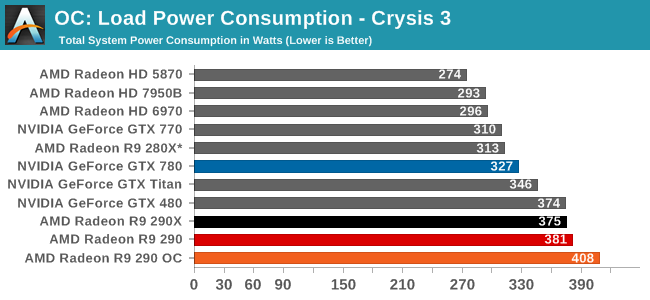
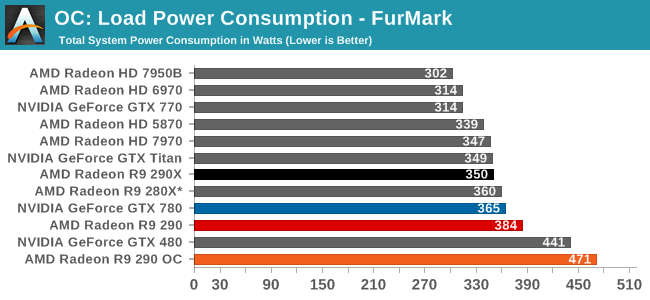
Taking a brief look at power, temp, and noise before jumping into our gaming performance results, we can see that overclocking the card has a measurable impact on power consumption under both Crysis 3 and FurMark. With Crysis 3 we’re clockspeed limited before we’re power limited, leading to an increase in power consumption of 27W, while under FurMark where we were power limited it’s a much more academic increase of 87W.
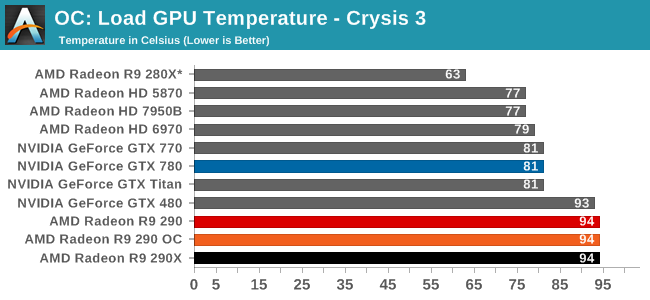
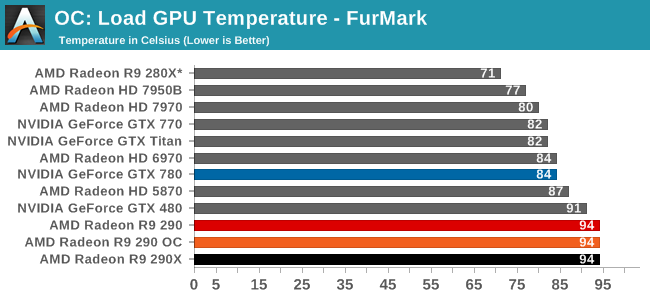
Since the 290 already ships at the highest temperate limit it allows – 95C – our sustained temperatures are unchanged even after overclocking.
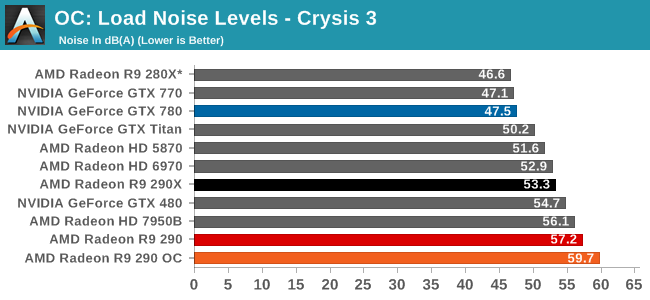
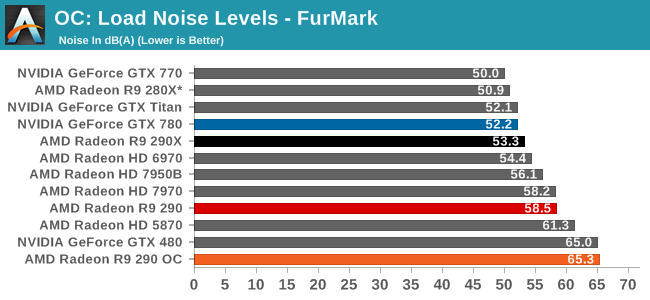
The 290 is already an unreasonably loud card at stock, and unfortunately the fan speed increases needed to handle the greater heat load from overclocking only make this worse. Under Crysis 3 we peaked at 59.7dB, or 49% fan speed. While under FurMark we peaked at 65.3dB, or 59% fan speed. For these noise levels to be bearable the 290 really needs to be fully isolated (e.g. in another room) or put under water, as otherwise 59.7dB sustained is immensely loud for a video card.
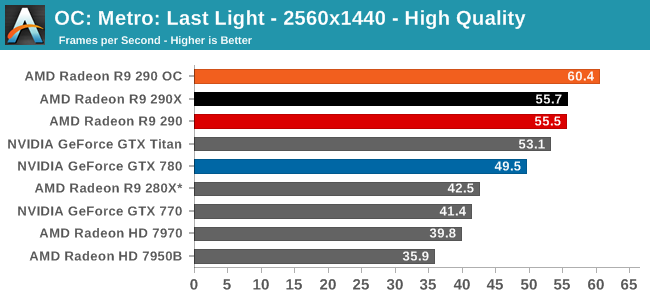
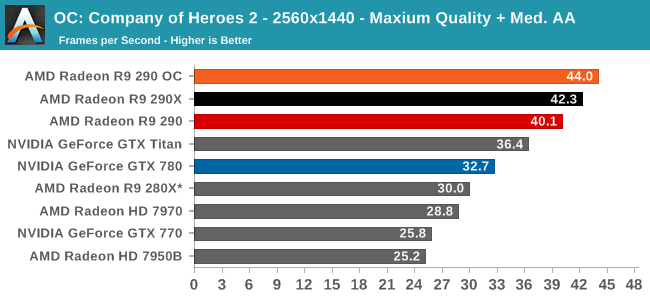
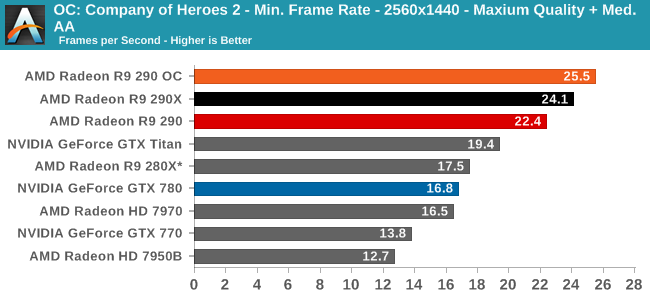
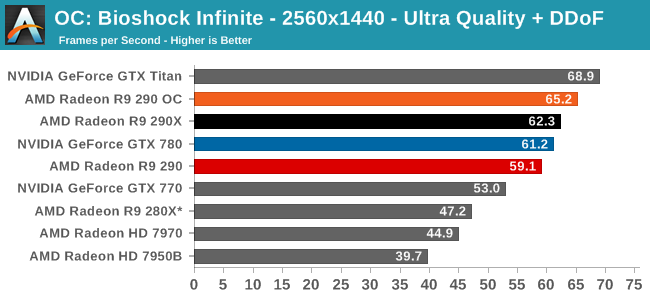
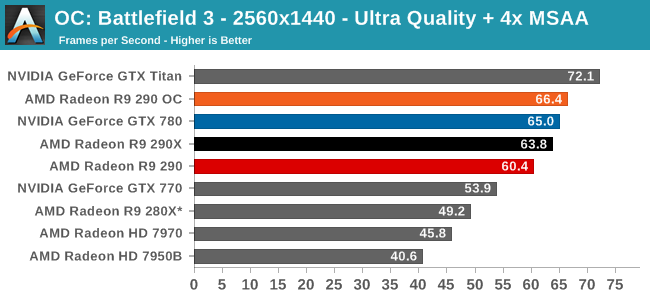
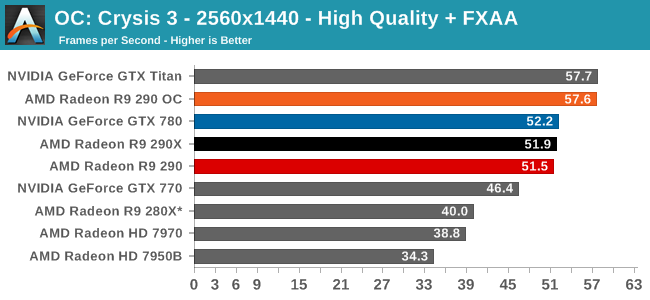
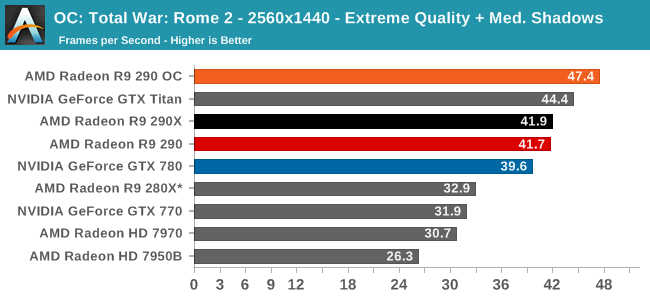
Finally getting to the matter of game performance, we’re seeing consistently strong scaling across every game in our collection. The specific performance increase depends on the game as always, but a 14% core overclock and 12% memory overclock has netted us anywhere between 9% in Metro up to the full 14% in Total War: Rome II. At this performance level the 290 OC exceeds the performance of any other single-GPU card at stock, and comes very close to delivering 60fps in every action game in our benchmark suite.










295 Comments
View All Comments
mattgmann - Tuesday, November 5, 2013 - link
I'd really like to see some benchmarks with this and the 290x under water.For someone like me that has already invested in building a water cooling setup and seen a few generations of hardware pass through it, the idea of watercooling the graphics card is a foregone conclusion.
The only added cost to me in upgrading the cooling is a few dollars worth of memory and other heatsinks to put on the card since I'd be using a universal gpu block.
I have a feeling that with the thermal levels in check, these cards will probably perform a good bit quicker than they already do (and that much more than the competition).
supamark - Tuesday, November 5, 2013 - link
"At the end of the day the 290 is 9.7dB louder than its intended competition, the GTX 780. With a 10dB difference representing a two-fold increase in noise on a human perceptual basis, the 290 is essentially twice as loud as the GTX 780."Un, no. Learn to dB... 3 dB would mean it's twice as loud, 10 dB means it's 10x as loud, the decibel is a log scale.
NomanA - Tuesday, November 5, 2013 - link
Human audio perception is also on a somewhat logarithmic scale. Twice as loud, doesn't mean, two times a certain value on a linear scale.supamark - Tuesday, November 5, 2013 - link
Sorry, but 3 dB is twice as loud. 10 dB, aka 1 Bel, is 10 times as loud. You hear 3 dB as twice as loud. You should just read this.... (3rd paragraph) instead of arguing.http://en.wikipedia.org/wiki/Decibel
kiwidude - Tuesday, November 5, 2013 - link
You are incorrect, 3dB represents a ratio of two to one or a doubling of power. Perception of loudness is not the same as sound pressure level or power. An increase of 10db SPL is perceived to be approximately twice as loud.I suggest you read instead of arguing. http://trace.wisc.edu/docs/2004-About-dB/
Sancus - Wednesday, November 6, 2013 - link
You're talking about power. Ryan Smith is talking about perceptual loudness. They're completely different. 10db does NOT sound 10 times as loud to your ear. It merely represents ten times as much power.http://trace.wisc.edu/docs/2004-About-dB/
piroroadkill - Wednesday, November 6, 2013 - link
You would need to start talking about human-hearing-weighted scales at that point to get any kind of "X as loud" to us, type measurements. Which is where dBA is often the go to scale.philosofa - Tuesday, November 5, 2013 - link
Don't quote me regulations. I co-chaired the committee that reviewed the recommendation to revise the color of the book that regulation's in. We kept it gray.Excellent editing ser :)
dudeofdur - Tuesday, November 5, 2013 - link
bracket + closed loop water cooler. Boom, solved your problemTorm - Tuesday, November 5, 2013 - link
It is sad when a review is so biased, that the reviewer doesn't appreciate extra performance. If you prefer a quiet card, turn the fan speed down. You are here to review the performance, and while the noise level is taken into consideration, in your final thoughts, you never once say "While the may be loud, you can always adjust fan levels to find the right sound for you." This card, by performance numbers, should have been a very high recommendation, with a note on it being loud. You decided in the review of the card, that you had rather recommend against it, as opposed to being honest. While I tested the card, I found it loud yes, but I also found that if I was an "Average" consumer, who will have their computer case sitting at least 2-3 feet from them, and listening to the audio of a game, movie, or music, that the audio difference between it and the 780 is barely noticed. This is a good review ruined by Biased minded comments. If you are looking for one of the best cards out there, and the BEST value for your money. This card IS it. Bar None. Just to be clear. I am a Hardcore Titan fan, but if I were to build a PC today, this would be the card I went with.